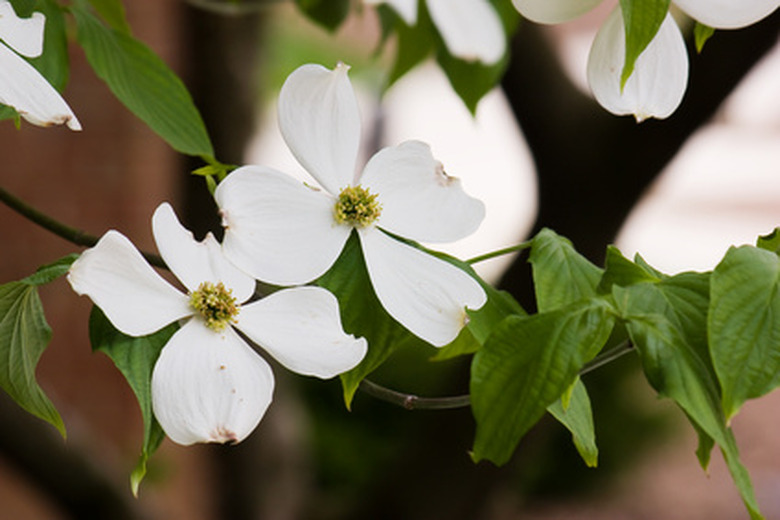Dogwood Tree Scientific Name Facts
Native to the partially shaded understory of the vast woodlands of the eastern United States, flowering dogwood attains a broad to cone-like shape about 20 to 30 feet tall and 20 to 25 feet wide. It is highly ornamental, flowering in spring and displaying purplish burgundy to pink-red fall foliage color. The white "flowers" we readily see are actually four bracts (modified leaves) that surround the cluster of tiny true flowers that are green-yellow. Grow flowering dogwood in U.S. Department of Agriculture Hardiness Zones 5 through 9.
Genus Designation
Flowering dogwood is botanically placed into the genus (group) named Cornus. It is one of about 40 other deciduous shrubs and trees in the genus, all native to temperate regions in the northern hemisphere. Logically, flowering dogwood is a member of the dogwood family, Cornaceae.
- Native to the partially shaded understory of the vast woodlands of the eastern United States, flowering dogwood attains a broad to cone-like shape about 20 to 30 feet tall and 20 to 25 feet wide.
- The white "flowers" we readily see are actually four bracts (modified leaves) that surround the cluster of tiny true flowers that are green-yellow.
Species
Flowering dogwood is a common name used for the species Cornus florida. While all dogwoods are flowering plants (angiosperms), they have other common names such as cornel, cornelian cherry, red osier, kousa dogwood, bloodtwig, redtwig and gray dogwood, among others. Thus, "flowering dogwood" has specific reference only to Cornus florida.
Etymology
According to Dr. Gerald Klingaman of Learn2Grow, the genus name Cornus is derived from the Latin word "cornu," which means "hard and bony projection that is shaped like a horn." "Cornus" is the word chosen and assigned to dogwood by Carl Linnaeus, the famed Swedish botanist who established the binomial system of scientific nomenclature. "Florida" means "flowering" in Latin, not referring to the American state of Florida, even though the tree is native to the northern half of the state.
Natural Forms
Within the species Cornus florida are two naturally occurring forms: florida and rubra. All plants that produce white bracts in the spring around the flowers are known as form florida (Cornus florida forma florida), while those that produce pink bracts are known as form rubra (Cornus florida forma rubra), according to the American Horticultural Society's "A-Z Encyclopedia of Garden Plants."
- Flowering dogwood is a common name used for the species Cornus florida.
- According to Dr. Gerald Klingaman of Learn2Grow, the genus name Cornus is derived from the Latin word "cornu," which means "hard and bony projection that is shaped like a horn."
- "
Cultivated Varieties
Over the last century, breeding and selection of mutations of flowering dogwood by horticulturists led to many cultivated varieties (cultivars). Each cultivar is assigned a cultivar name to distinguish it from other selections of flowering dogwood. Examples of cultivars include Cloud Nine, White Cloud, First Lady, Cherokee Chief, Hohman's Gold, Pendula, Pluribracteata, Purple Glory and Spring Song, among others. In the late 20th century, plant breeders began hybridizing flowering dogwood with Japanese kousa dogwood (Cornus kousa) to produce more disease-resistant trees. Such hybrids are written with the botanical name Cornus x rutgersensis, according to "Sunset Western Garden Book" or without a species name so the cultivar name immediately follows the genus name Cornus.
References
- "A-Z Encyclopedia of Garden Plants"; Christopher Brickell and H. Marc Cathey, eds.; 2004
- "Sunset Western Garden Book"; Kathleen Norris Brenzel, ed.; 2007
